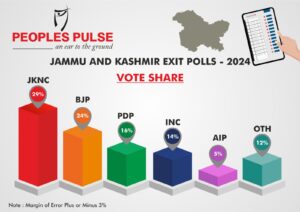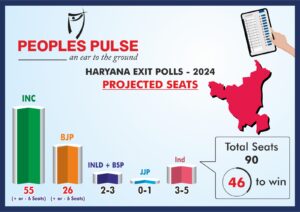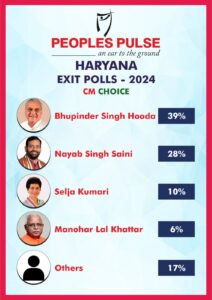The survey found that though JKNC-INC coalition would bag more seats, it would fall short of the majority to form the government.
Published Oct 05, 2024 | 6:05 PM ⚊ Updated Oct 06, 2024 | 12:18 AM

The JKNC-INC alliance appears to have an edge, with the potential to secure between 46 and 50 seats. (People's Pulse)
No political party is expected to reach the halfway mark of 46 seats in Jammu & Kashmir. However, according to an exit poll survey, the Jammu Kashmir National Conference-Congress alliance is likely to win most seats.
Elections — the first after the abrogation of Article 370 — to the 90-member Legislative Assembly were held in three phases from 18 September to 1 October.
The survey by Hyderabad-based People’s Pulse found the National Conference-Congress alliance has curried favour with the electorate, as a considerable percentage of respondents expressed their support for it.
In Haryana, the survey found the Congress likely to put the brakes on the BJP’s 10-year rule by winning more than 46 seats — necessary to form the government — in the 90-member state legislative Assembly.
Approximately 46 percent of those surveyed in Jammu and Kashmir believed that the INC-JKNC alliance would best serve their interests.
In terms of vote share the post-poll data indicated that the alliance is likely to secure around 43% of the total votes, with the JKNC contributing about 29% and the INC garnering around 14%.
The BJP, buoyed by a consolidation of the Hindu vote in Jammu, is expected to capture around 24% of the vote share. Meanwhile, the PDP is projected to secure 16%, with smaller parties like the Awami Ittihaad Party, People’s Conference, and Apni Party, etc. together accounting for the remaining 17%.
The post-poll data suggested that no single party will reach the majority mark of 46 seats, pointing toward a coalition government in Jammu and Kashmir once again.

Vote share. (People’s Pulse)
The JKNC-INC alliance, however, appears to have an edge, with the potential to secure between 46 and 50 seats. Of these, the JKNC is expected to contribute between 33 and 35 seats, while the INC may secure 13 to 15 seats.
On the other hand, the BJP, benefiting from its strong performance in Jammu, and aided by lacklustre campaigning by INC, is projected to stand anywhere between 23to 27 seats — less than what they would have liked to get after investing so much in J&K.
The PDP is expected to hold a significant presence, with estimates suggesting it could secure between seven and 11 seats. The much-hyped Awami Ittihaad Party could win one seat, and smaller parties, such as the People’s Conference and Apni Party, may secure around four to five seats combined.
Unemployment emerged as the most pressing issue for voters in the 2024 elections. Nearly half of the respondents identified unemployment as their primary concern.
This sentiment reflected the challenges faced by the region in terms of job creation and economic growth.
Other prominent issues influencing voting decisions included development, inflation, increased power terrified access to essential services.
Overall while over 30% of respondents acknowledged the overall improvement in development, however, more than 40% believed there was no change in the last five-six years, while 22% believed it has worsened.
Interestingly, despite economic concerns dominating voter preferences, security-related issues also played a role in shaping opinions. Only 30% of respondents believed that the law-and-order situation had improved significantly in recent years.
This revealed a level of dissatisfaction with the current security environment despite the government’s repeated assurances of progress in this area.
The 2019 revocation of Article 370, which stripped Jammu and Kashmir of its special status, continued to evoke strong opinions among the electorate.
The survey revealed that a majority of respondents expressed dissatisfaction with particularly downgrading J&K from state to Union Territory doesn’t find acceptance with the people as around 67% of respondents believed that J&K was better as a state.
On governance, only 30% of respondents believed that the region has seen significant development since the change in its political status. A large section of the electorate expressed concerns about the pace of development, particularly in terms of infrastructure, healthcare, and education.
In terms of leadership, the survey showed that Omar Abdullah of the JKNC is the most popular choice for chief minister, with around 28% of respondents backing him for the position.

Preferred chief minister. (People’s Pulse)
Abdullah, a former chief minister, has remained a key figure in the region’s politics, and his popularity reflects a desire among many voters for a return to experienced leadership.
The 2024 Jammu and Kashmir Assembly elections marked a crucial moment in the region’s political landscape following a nearly decade-long hiatus. The last assembly elections were held in 2014 when the Bharatiya Janata Party (BJP) and the Jammu and Kashmir Peoples Democratic Party (PDP) formed a post-poll alliance to govern the then-state.
However, the coalition was dissolved in 2018, and Jammu and Kashmir underwent a significant transformation in 2019 when it was bifurcated into two Union Territories: Jammu and Kashmir and Ladakh. This transformation, along with the revocation of Article 370, has made the 2024 elections particularly significant.
The elections were held under a new delimitation exercise conducted in 2022, which increased the number of assembly seats from 83 to 90. This expansion has changed the electoral dynamics and has led to a fierce contest among political parties.
Peoples Pulse research organisation conducted the post-poll survey to understand voter sentiments, preferences, and key issues that influenced this election. Post-Poll Survey was conducted in September and October 2024 in 25 Assembly Segments in J & K selected based on probability Proportional Methodology (PPS).
The survey was conducted in four polling stations selected from each Assembly segment using systematic random sampling. In each polling station, 15-20 respondents were selected from the electoral tolls. A total of 2016 samples were chosen such that the sample reflects the situation on the ground in terms of caste, religion, and age.
Gender was given equal representation. The survey consisted of a structured questionnaire, with face-to-face interviews. Research scholars and PG students in Jammu & Kashmir conducted the survey.
People’s Pulse predicted a Congress sweep in Haryana, with the more-than-a-century-old party winning 55 seats (+ or – 6).
It predicted the BJP to trail with 26 seats (+ or – 6), with the Indian National Lok Dal (INLD) grabbing two to three seats, Independents three to five, and Jannayak Janata Party (JJP) one seat. The exit poll was held on Saturday, 5 October.
The survey noted that regional parties like the INLD and JJP, which have played a key role in Haryana politics, seem to be losing traction, which was also evident from the 2024 Parliament election results.
The survey found a combination of factors going against the BJP. The two significant sections –farmers and youth, are ranged against the saffron party, as well as the community of wrestlers.

Congress is likely to come to power in Haryana.
From a caste point of view, the Congress is getting the support of the Jats and Dalits, apart from many other smaller communities. While the influence of Jats over Haryana politics is well known, Dalits account for little over 20 percent of the state’s population.
The OBCs are sailing with the BJP but it is not enough to pull the party through. The BJP’s efforts to create a Jat vs non-Jat narrative in this election did not seem to have worked.
Going by the survey results, the Congress has a clear edge of seven to eight percent in terms of vote share vis-a-vis its main rival, BJP. The Congress is expected to garner a 45 percent vote share while the BJP is trailing at around 38 percent,
INLD-BSP may get 5.2 percent, JJP, and AAP 1 percent, JJP less than 1 percent, and others 7-8 percent. The survey factors a margin of error plus or minus 3 percent regarding the vote share projected.
The BJP is holding ground in the Faridabad (barring Nuh district) Aheerwal region and the Karnal-Panipat region falling on the GT Road belt while Congress seems to be picking up in Hisar, Ambala, and Rohtak regions.
The drop in the performance of the BJP is not surprising considering that the party has been in power for 10 years. The decline began in 2019 itself. It was with the support of JJP that the BJP was able to form the government. But, this time, there is no scope for smaller parties to play any role.

Hooda is the preferred chief minister candidate.
The most preferred choice for the post of chief minister is Bhoopinder Singh Hooda. What was witnessed this time was an increase in the preference among voters across parties for a local leader of their region to be the chief minister. Hence, the popularity of Kumari Selja increased not only among Dalit voters but also among voters in the Hisar-Sirsa region, across parties.
Sections of even BJP voters in Kaithal preferred Randeep Surjewala to be their chief minister. Even Congress-inclined voters in Amabala preferred Anil Vij of BJP as their chief minister. The reasons cited were fear of discrimination against their region if the chief minister is from another region.
This sentiment was especially evident against Bhupinder Singh Hooda as voters from other regions like Faridabad, Sirsa-Hisar, and Ambala feared all major development would go to the Rohtak region if he became the chief minister.
Local issues were dominant in the assembly elections while national issues took a back seat. Due to this, the Modi factor did not work much this time.
Unemployment, inflation, and farmers’ protests also influenced voting preferences. Youths talked about increasing joblessness and questioned both state and central governments. They mentioned the Agniveer scheme, which according to most of the youth respondents, has decreased the attraction to serving the armed forces.
Both men and women respondents across regions and communities raised the issue of inflation. In rural areas, the majority of farmers, barring in the Aheerwal region, talked about the negative role played by the Haryana government in curtailing the farmers’ protest.
The issue of family ID in Haryana is serious, especially in rural areas. Due to incorrect surveys, many families are being deprived of government facilities. This is hurting their economic situation and living standards.
Another major finding was that a significant number of sitting MLAs from all parties are facing acute anti-incumbency sentiments, which includes some of the state ministers.
The survey found that voters have lost faith in the JJP. The INLD-BSP alliance is likely to be the third biggest vote share gainer, but in terms of seats, they may have to remain satisfied with 1 to 3 seats. Besides, the AAP is also not likely to win a single seat.
However, independent candidates are likely to win or spoil equations on several seats. One such seat is Hisar where BJP rebel and independent candidate Savitri Jindal has a decisive edge. The same goes for Pundri where Congress rebel independent Satveer Bhana is leading among all candidates.
The survey found that the support for the BJP has decreased among Dalit and OBC voters.
Most of the general caste voters, other than Jats, are more inclined towards the BJP than the INC. However, in some urban seats, fragmentation among the general voters, especially Punjabi-Baniya and Brahmin voters, seemed to have favoured others. Such seats include Ambala Cant and City, Hisar, Jind, Kaithal, Tosham etc.
The survey also found an increased support for Congress among the scheduled caste voters.
Haryana doesn’t boast of having a committed women’s vote bank like West Bengal. Mostly, women vote according to family preference and caste equations. However, issues like inflation, joblessness, and anti-incumbency have also affected them and due to that, women voters are slightly more inclined towards Congress.
Youngsters are quite vocal in criticizing the government, especially over the issue of jobs, and it is likely to benefit Congress.
(Edited by Majnu Babu).
